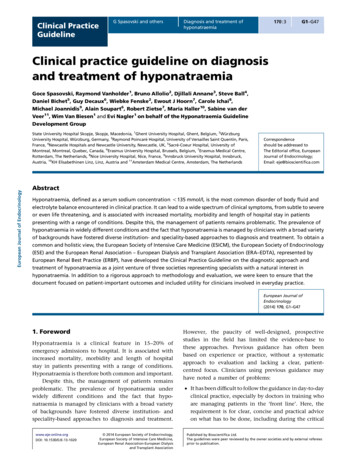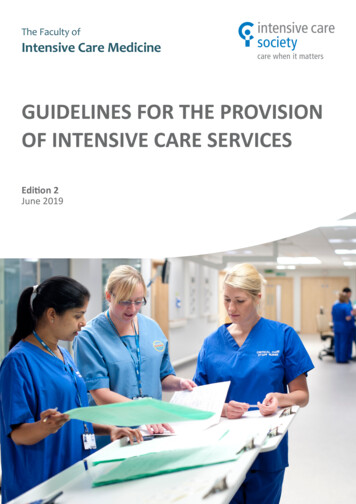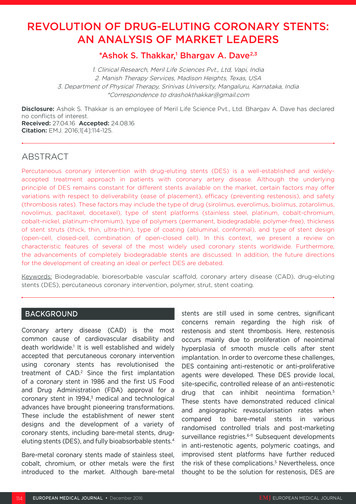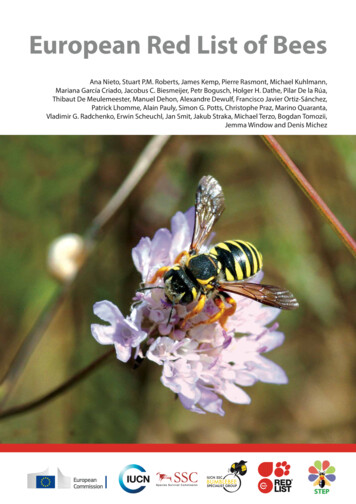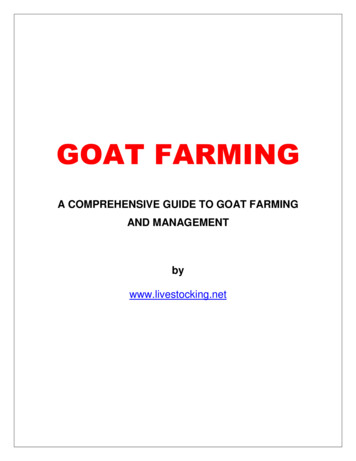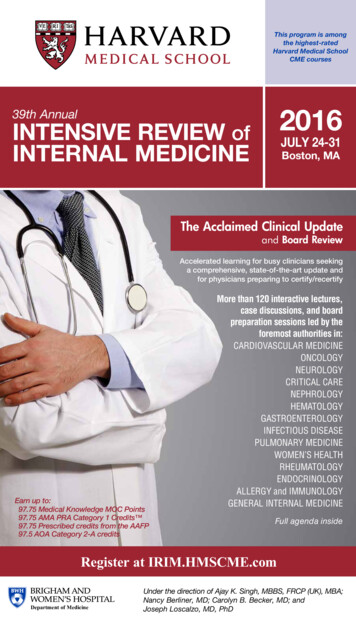
Transcription
INTENSIVE REVIEW GUIDEAPEUROPEANHISTORY
Table of ContentsAP EURO REVIEW SHEET #1: . 1AP EURO REVIEW SHEET #2: . 2AP EURO REVIEW SHEET #3: . 3AP EURO REVIEW SHEET #4: . 4AP EURO REVIEW SHEET #5: . 6UNIT 1 STUDY GUIDE: . 8UNIT 2 STUDY GUIDE: . 10UNIT 3 STUDY GUIDE: . 14UNIT 4 STUDY GUIDE: . 18UNIT 5 STUDY GUIDE: . 24
1AP EURO REVIEW SHEET #1:European WarsFor each of the following wars, make simple notes of the following :Causes, Course, Consequences, Conquerors, ConqueredHundred Years’ War (1337-1453)Fall of Constantinople (1453)Reconquista (Completed in 1492)War of the Roses (1455-1485)Ottoman-Hapsburg Wars (1526-1791)Key Battles: Siege of Vienna (1529) Marked end of the Ottoman Empire’s expansioninto EuropeDefeat of the Spanish Armada (1588)French Wars of Religion (1562-1598)Thirty Years’ War (1618-1648)English Civil War (1641-1651)War of Spanish Succession (1701-1714)Great Northern War (1700-1721)Key Battles: Narva, PoltavaSeven Years’ War [a.k.a., French and Indian War] (1756-1763)American Revolutionary War (1775-1783)Napoleonic Wars (1803-1815)Key Battles: Austerlitz, WaterlooCrimean War (1853-1856)Wars of German UnificationAustro-Prussian War (1866)Franco-Prussian War (1870-1871)World War I (1914-1918)World War II (1939-1945)Key Campaigns: Operation Torch, Battle of Britain, D-Day, Battle of the Bulge
2AP EURO REVIEW SHEET #2:Treaties and International AgreementsTreaty of Tordesillas (1494)Divided the “New World” between Spain and PortugalTreaty of Westphalia (1648)Ended the Thirty Years’ War and established international boundariesTreaty of Utrecht (1713)Ended the War of Spanish Succession (and Louis XIV’s Wars)After fighting the British-led coalition to a stalemate in the War of Spanish Succession, it was agreed thatLouis XIV’s grandson would be placed on the Spanish throne under the condition that the French andSpanish monarchies would never be united. The French and Spanish Bourbons each renounced anyclaims to the other throne.Treaty of Versailles (1919)Ended World War IGOOD COPWoodrow Wilson’s Fourteen PointsBAD COPArticle 231 – German “War Guilt Clause”Freedom of the Seas, Open Treaty Negotiations,Self-determination of Peoples, League of Nations,etc.Germany obligated to pay reparations to the victorsNorth Atlantic Treaty Organization (NATO) (1949)Collective Defense Pact – Western Europe and North AmericaNATO still exists and now includes many former members of the Warsaw Pact (below).France pulled out of the military structure of NATO in 1966.The Warsaw Pact (1955)Collective Defense Pact – Eastern Bloc (Communists)Founded in response to NATOThe Warsaw Pact was disestablished in 1991.Maastricht Treaty (1991)Created the European Union
3AP EURO REVIEW SHEET #3:The Balance of Powerhttp://en.wikipedia.org/wiki/European balance of powerHapsburgs, Bourbons, and British (Seventeenth Century)British: Keep any royal house from establishing a universal monarchy on the continent (a la Napoleon)Hapsburgs: Two branches of this family held the crowns of Austria, Spain, and the Holy Roman EmpireBourbons: New royal house of France with ambitions of expandingIn the late seventeenth/early eighteenth century, Louis XIV constituted the single greatest threat tothe Balance of Power. The Treaty of Utrecht (1713) ended Louis’ expansionism, but did place a Bourbonon the Spanish throne.The “Great Powers” (Eighteenth Century)France, Britain, Austria, Prussia, and RussiaPartitioning of PolandPrussia, Russia, and Austria agree to partition Poland, a weak confederation of nobles with an electedking. Since all three nations participated, the Balance of Power was not threatened.Concert of Europe (1815-1878)Established at the Congress of ViennaPost-Napoleonic effort to maintain cooperation amongst the Great Powers to stop revolutionarymovements and prevent another Napoleon-type figure from disrupting the Balance of Power. Therewere no continent-wide wars between 1815 and 1914, so this arrangement was pretty successful. Thearrangement showed signs of fragmentation in the late nineteenth century.German Unification (1871)German Unification was a major event that disrupted the Balance of Power in Europe through WWII.League of Nations (1919-1939)International Body Created by the Versailles TreatyGoal: To prevent war through disarmament and collective defense that worked out well! TheUnited States never joined and the organization basically disintegrated during World War II.The Cold War (1946-1991)NATO vs. Warsaw PactThis time, the alliance system worked! The Balance of Power was modified after World War IIwith the partitioning of Germany and the entry of the United States into active association withThe European Union (1991-Present)
4AP EURO REVIEW SHEET #4:Monarchs, Intellectuals, Religious and Political LeadersI made this list using exclusively names that came to my head. These individuals are what I wouldconsider the bare essentials for anyone claiming to be at least somewhat literate in European history.The RenaissanceWars of ReligionItalian RenaissancePetrarchMachiavelliLorenzo de MediciFerdinand II (HR Emperor)Cardinal RichelieuGustavus AdolphusHenry IV of FranceNorthern RenaissanceThomas MoreDesiderius ErasmusThe Age of AbsolutismThe “New Monarchs”EnglandHenry VIISpainFerdinand and IsabellaThe Age of ExplorationPrince Henry the NavigatorVasco da GamaChristopher ColumbusThe ReformationJohann TetzelMartin LutherPope Leo XCharles V (Holy RomanEmperor)John CalvinUlrich ZwingliHenry VIIIEdward VIElizabeth IMary IThomas CranmerJohn KnoxIgnatius LoyolaTheresa of AvilaLouis XIVCardinal MazarinJean-Baptiste ColbertPeter the GreatFrederick, the Great ElectorMaria-Theresa (Austria)English ConstitutionalismThe StuartsJames ICharles ICharles IIJames IIOliver CromwellJohn LockeWilliam III and Mary IIQueen AnnePhilosophersJacques BossuetJean BodinThomas HobbesJohn Locke
The Scientific RevolutionCopernicusGalileoFrancis BaconIsaac NewtonRene DescartesThe EnlightenmentMontesquieuVoltaireDenis DiderotDavid HumeImmanuel KantJean-Jacques RousseauEnlightened AbsolutismCatherine the Great (Russia)Frederick the Great (Prussia)Joseph II (Austria)The French Revolution andNapoleon5Edmund Burke (as a critic of)Mary WollstonecraftMarquis de LafayetteAbbe SieyesJean-Paul MaratRobespierreOlympe de GougesDantonNapoleon BonaparteArthur Wellesley, Duke ofWellingtonLouis XVIMarie AntoinetteAP EURO REVIEW SHEET #4:Monarchs, Intellectuals, Religious and Political Leaders(Continued)Early Nineteenth CenturyCongress of Vienna/ConservatismKlemens von MetternichAlexander I of RussiaThe Industrial RevolutionJames WattThomas MalthusDavid RicardoLiberalismAdam SmithFrederic BastiatSocialismKarl MarxRomanticismWilliam BlakeLate Nineteenth CenturyQueen VictoriaBenjamin DisraeliWilliam GladstoneSir Cecil RhodesCapt. Alfred DreyfusTheodor HerzlCharles DarwinOtto von BismarckAlexander II of RussiaAlexander III of Russia
6World War IArchduke Franz FerdinandWilhelm II (“Kaiser Bill”)David Lloyd GeorgeGeorges ClemenceauWoodrow WilsonNeville ChamberlainWinston ChurchillFranklin D. RooseveltGen. Charles de GaulleField Marshal Bernard MontgomeryGen. Dwight D. EisenhowerThe Cold WarRussian RevolutionHarry TrumanNikita KhrushchevJohn F. KennedyLeonid BrezhnevMikhail GorbachevRonald ReaganNicholas IIRasputinVladimir LeninModernismSigmund FreudFrederich NietzscheContemporary EuropeTotalitarian Dictators and WWIIBenito MussoliniJoseph StalinAdolf HitlerSimone de BeauvoirMargaret ThatcherBoris YeltsinTony BlairAP EURO REVIEW SHEET #5:Understanding Women(enough for the AP exam, at least!)First off, the Roman Catholic Church has NEVER seriously considered ordainingwomen into the priesthood. There will likely be a question on the exam aboutthe Catholic Church and ordaining women will be a distractor.Sixteenth Century(1500s)Seventeenth CenturyNo political or property rights(although some women reigned as monarchs andsome wealthy women patronized the arts)(1600s)Eighteenth Century(1700s)Nineteenth Century(1800s)ENLIGHTENMENT: Women hosted salons,published books and papers, and participated inintellectual lifeINDUSTRIAL REVOLUTION: Lower class womenworked in textile millsLIMITED PROPERTY RIGHTS: Late eighteenthcentury/early nineteenth centuryDOMESTIC SERVANTS: During the eighteenth and
7nineteenth centuriesTwentieth Century(1900s)CULT OF DOMESTICITY – Women were expected tostay at home during the Victorian EraBefore the twentieth century, most secretarieswere MEN. Women started doing secretarial workin the twentieth century.Before the twentieth century, it was unusual to seewomen in the “professions” (medicine, law, etc.)VOTING: During World War I, women worked inthe armaments industry. Just like in the UnitedStates, several European nations recognized therights of women to vote (suffrage) between 19151930.EQUAL PAY: No one really discussed this until afterWorld War II and the modern feminist movement
8UNIT 1 STUDY GUIDE:The RenaissanceWorks of Literature:Petrarch, Il CanzoniereThomas More, UtopiaMachiavelli, The PrinceErasmus, The Praise of FollyCharacteristics of the Italian Renaissance:Characteristics of Classical Art:1.1.2.2.3.3.4.4.5.HumanismCiceroHumanists have a fascination with , , andliterature.The Italian RenaissancePeople to Know:PetrarchLorenzo de Medici(City)The Northern RenaissanceComparison to the Italian Renaissance:People to Know:Thomas More (English)Erasmus (Dutch)Humanists and the BibleJohannes Gutenberg (German)
9The “New Monarchs”SPAINENGLANDNew MonarchsMajor WarsConsolidation ofPowerThe New Monarchs, in general, increased the power of the monarchy as the power of theand the declined.The Age of ExplorationThree G’s:G , G ,and GMotives:1. Economic – All water route2. Religious – P JPORTUGALPrince Henry the NavigatorSPAINColumbus
10Vasco da GamaMagellanRESULT:UNIT 2 STUDY GUIDE:The Reformation(s)Problems in the Catholic Church (Sixteenth Century): Simony Uneducated Priests Nepotism Corruption Pluralism of Offices Sale of Indulgences AbsenteeismTHE EUCHARISTJohann TetzelTRANSUBSTANTIATIONMartin Luther(Roman Catholic)95 ThesesCONSUBSTANTIATIONFrederick of Saxony(Luther/Calvin)Charles VDiet of Worms (1521)MEMORIAL(Zwingli/Anabaptists)German Peasants’ Revolt (1524-1525)Peace of Augsburg (1555)cuius regio, eius religio ( )Choices:orCounter-ReformationIgnatius LoyolaTeresa of AvilaSociety of Jesus (a.k.a., )Catholic Nun and Mystic
11Council of Trent (1545-1563)WHAT IT DIDWHAT IT DIDN’T DO
12REFORMATION GRAPHIC ORGANIZERCATHOLICISMENGLANDLUTHERCALVINISM(The Status Quo)(Conservative Reform)(Moderate Reform)(Radical Reform)Henry VIIISolaof GodDefense of theSacramentsSolaPre-Justification by aloneAct ofBook of James:AbolishedTUAn “Epistle of ”LPilgrimage of GraceSupport for Secular AuthorityIThomas CranmerArchbishop ofBook ofEdward VI (r. 1547-1553)Priesthood ofPCalvinists inEnglandScotlandMary I (r. 1553-1558)JohnElizabeth I (r. 1558-1603)France
13Religious WarsFrench Wars of ReligionCatholics vs.(French Calvinists)Thousands of Huguenots Killedof Navarre (Huguenot)Dynasty“Paris ” (Converted)Henry was a , a pragmatist who considered concerns of state tobe more important than fighting over religion.Henry IVThe Edict of , Henry proclaimed limited toleration for FrenchCalvinists (later rescinded by his grandson, Louis XIV).The Thirty Years’ WarPRIMARY BATTLEGROUND:MASSIVE DESTRUCTION(1618- )Over 50% dead in some areasPhasePhasePhasePhaseThe Peace of (1648)
14UNIT 3 STUDY GUIDE:Absolutism and nges to Absolutism1.N4.T2.C5.U3.RLouis XIVPeter the Great“The Fredericks”of Franceof Russiaof PrussiaThe “ King”Boyars"L'État, c'est moi"Ivan the Terrible had already reducedthe power of the boyars a centurybefore, but Peter furthered this trendtoward absolutism.“Un roi, une loi, une foi.”FrondeVersaillesTable of RanksRussian Orthodox ChurchReformPrussia-Brandenburg“The of theHoly Roman EmpireDevastated by the ThirtyYears’ WarHouse of HohenzollernFrederick William I“The Great Elector”Power to tax by decreeEdict of NantesWesternizationGallicanismWarsJ.B. Colbert and MercantilismWar of Spanish SuccessionAzov CampaignsGreat Northern WarPurpose: PortsKings of PrussiaFrederick IFrederick William IFrederick II “the Great”Prussian MilitarismPrussia made up for its small sizeby maintaining a large, welltrained army.All absolute monarchs maintained large standing armies. Constitutional societies, such as England,were highly suspicious about peacetime standing armies for this reason.
15The Development of English ConstitutionalismDuring the Stuart Dynasty1603 – Death of Elizabeth I, the “Virgin Queen,” ending the Tudor dynasty. James VI of Scotland, ofthe Stuart dynasty, was invited to reign in England, in addition, becoming James I of England.James I(r. 1603-1625)Charles I(r. 1625-1649)INTERREGNUMa.k.a., ProtectorateEnglish Civil War (1641-1651)Cavaliers vs.(Puritans)Oliver Cromwell -(1649-1660)Charles II“Restless he rolls from whore to whore(r. 1660-1685)A monarch, scandalous and poor.”-- From a poem by the Earl of Rochester, Charles II’s friendJames II(r. 1685-1688)GLORIOUSREVOLUTIONAbdicatedENGLISH BILL OF RIGHTS(1688)William III (of Orange)and Mary II (Stuart)John Locke publishes Two Treatises on Government(r. 1689-1702)Anne(r. 1702-1714)Queen during the War ofSpanish SuccessionChildlessEND OF STUART DYNASTYSTUARTS GRAPHIC ORGANIZER----------INTERREGNUM----------FACT:The Stuarts were succeeded by the House of Hanover, aGerman noble house with blood ties to the House of Stuart:Hanoverian Dynasty (1714-1901):George I, II, III, and IV, William IV, Victoria-----GLORIOUS REVOLUTION-----
16Philosophers of Absolutism and ConstitutionalismJean Bodin and Jacques Bossuet(Divine Right Absolutism)Bodin and Bossuet both argued that sovereignty resides in a monarch andCharles I receiving a crown from a hand above. James I and Charles I tried toput Divine Right theory into practice in England. Charles I paid for this with hislife.Louis XIV, on the other hand, ruled by this philosophy and lived to a ripe oldage.Thomas HobbesJohn Locke(Philosophical Absolutism)(Constitutionalism)LeviathanTwo Treatises on GovernmentJob 24 (Description of the Leviathan)BACKDROP:English Civil War (Bloody)BACKDROP:Glorious Revolution (Peaceful)NATURAL RIGHTS:LLPConsent of the Governed / Right of RevolutionWHERE HOBBES AND LOCKE AGREE:Hobbes and Locke both rejected “divine right” theory. Both wrote that the first people are born intoa state of nature, in which there was no government. In this state of nature, people have no way ofprotecting themselves or their property. For this reason, people form governments.The only way to keep people from destroyingPeople establish governments to protect theireach other is to have an absolute ruler that is sonatural rights of LIFE, LIBERTY, and PROPERTY.powerful that no one could ever think ofGovernments are agents of the people in thischallenging him. People choose a sovereignregard, and can only act with the CONSENT OFmaintain order by governing absolutely. People THE GOVERNED. The people maintain theirdo not have a right to overthrow the sovereign,sovereignty and may overthrow any governmentas that brings things back to the state of war.that fails to protect natural rights.
17The Dutch RepublicMERCHANT OLIGARCHYThe Dutch Republic was governed by a council ofwealthy merchants.COMMERCIAL GIANT IN SEVENTEENTHCENTURYAmsterdam, as can be seen on the map tothe right, is a natural port city.The Dutch provided the cheapest shipping rates inEurope at the time and dominated European (and,thus, international) commerce during theseventeenth century.They also established one of the first modern stock markets, which helped to raise capital forcommercial ventures.LIMITED RELIGIOUS TOLERATION (any toleration was rare at this time in Europe)The Dutch Republic was dominated by Calvinist merchants. While the Dutch did not allow publicexpression of competing religion, they allowed Jews and Catholics to practice their religions in private.This policy attracted Jews from other parts of Europe (where they were still being persecuted), whobecame active in the vibrant business community. The Dutch were some of the first people to figureout that religious intolerance is not good for business.Here is an interesting article about religious toleration in the Dutch k.pdfDUTCH GOLDEN AGE ARTDutch art tended to picture people in everyday situations, such as the paintings below. Note theCalvinist simplicity with which the subjects are dressed.The Account KeeperNicolaes Maes,1656A Woman Holdinga BalanceJan Vermeer,1662For more information on Dutch Golden Age Art: http://en.wikipedia.org/wiki/Dutch Golden Age painting
18UNIT 4 STUDY GUIDE:The Scientific RevolutionPtolemyCopernicusKeplerGalileo(Ancient Roman)(Polish)(German)(Italian)Geocentric TheoryTRADITIONHeliocentric TheoryHYPOTHESISMATHEMATICAL e “natural philosophers” of the early modern period believed thattrue knowledge comes from experience. The scientific method wasdesigned as a system for collecting empirical ce“Natural Philosophers” of the Scientific ascalCountry of OriginContribution(s)
19The Scientific Method and Inductive ReasoningImage Credit: http://scifiles.larc.nasa.govDeductive ReasoningInductive Reasoning(Aristotle)(Bacon and Descartes)Sir Francis and Rene were instrumental in formulatingthe scientific method, which created a fixed system of scientific inquiry that was accepted bynatural philosophers throughout Europe.AcademiesAbsolute monarchs established Royal in orderto promote scientific inquiry. These monarchs were not interestedin scientific advancement for its own sake, but in the possibilitiesscientific inquiry had to produce wealth (alchemy) and new militarytechnologies.WealthWarmakingWeaponry
20The [British] Agricultural RevolutionThe application of principles and capitalism to agricultureEReplaced the ,where the whole communitywould plant crops and grazetheir livestock.IJethroS BreedingThe process of breeding animalsThe , with desirable characteristicswhich mechanized sowing, was together to produce geneticallysuperior livestockTull’s most famous invention.
21The EnlightenmentVALUES OF THE NWhat isImmanuel Kant, a German philosophe, defined “enlightenment” as an individual’sEnlightenment?escape from - a sort of self-imposed intellectual childhood.Enlightened individuals are capable of thinking for themselves.According to Kant, the only thing necessary to escape from nonage is . Twoinstitutions dominant in France at the time limited freedom of inquiry:Freedom-limiting Institutionsin the eyes of the philosophes:Most philosophes were anticlerical (against theinfluence of a hierarchical, institutional Churchorganization – not necessarily against the generalconcept of religion) in their thinking.“And his hand would plait the priest’s entrails, Forwant of a rope, to strangle kings.”-- DiderotNatural ReligionRevealed Religion(e.g., )(e.g., )Knowledge of God comes from:Knowledge of God comes from:The religion of Deism, which boasted such illustrious adherents as Voltaire, Thomas Paine, andThomas Jefferson, was a natural religion. The metaphysics of Deism are fairly easily explained:God exists. He created an orderlyuniverse and made it possible forhuman beings to understand himthrough the use of observation andreason. Sacred texts claiming to contain the revealedword of God Religious dogmas derived from said texts Miracles, prophecies and religious "mysteries"
22Although enlightened ideals spread throughout Europe,was the epicenter of the Enlightenment.The French “Philosophes”PhilosopheNotable Published Work(s)Contribution(s) to Enlightened ned AbsolutismAbsolute monarchs in Central and Eastern Europe took an interest in the ideals ofthe Enlightenment, seeing in them an opportunity to modernize and consolidatetheir states.The Enlightened Despots(Prussia)(Austria)(Russia)A ruler is theThe ambitious,of the state.but thesuccessful of the enlightenedRaised to the throne afterparticipating in a conspiracy toassassinate her husbandPurchased ’slibrary and paid him to be theLifted restrictions on s. librarian(Religious Group)’s Rebelliondespots.“Only one ruler in the world says: ‘Argue as much asyou please, but obey!’” – KantAlthough the enlightened absolutists promoted religioustoleration, education, and other benevolent reforms, theytended to promote these ideals only to the point to which theThe Program of the Enlightened Absolutists: Religious TolerationFree Speech and PressPrivate Property RightsPatronage of the Arts and SciencesRebellion
23ideals furthered their goals. Ultimately, the enlightenment idealof freedom would prove incompatible with absolute rule.
24UNIT 5 STUDY GUIDE:The French Revolution and NapoleonThe Old Regime1st Estate2nd Estate3rd EstateClassesTHE PROBLEM:By 1787, the French monarchy was nearly bankrupt,partially due to its inability to tax the privilegedorders.France’s support for the Revolution(Anti-British) brought the French treasury to the crisis point.Major Events of the French Revolution:17Louis XVI calls an Assembly of , requesting permission totax the First and Second Estates. The privileged orders refuse to cooperateand insist that the Estates General be called.The Liberal Phase (1789-1792)17Dominant Class:Louis XVI calls the , but according toold guidelines, with each of the estates receiving one third of therepresentatives and voting as a class.What is the Third Estate?(Abbe )What is the Third Estate?What has it been in the political order?SieyesWhat does it desire to be?The Third Estate proposed two reforms in order to make their representation more equitable:“ ” the Third2XVote byLouis agreed to double the amount of Third Estate delegates, but did not agree to vote by head,rendering the doubling useless. The Third Estate delegates eventually walked out of the Estates General.
25The Third Estate delegates, along with some representatives of the clergy and nobility, formed the. When they were locked out of theirmeeting room, they swore the Oath,pledging not to adjourn until they provided France with a constitution.The National Assembly’s goal was to create a alongthe model of the government.Also in 1789:The Declaration of the of and the Citizenstated basic human rights (free speech, press, etc.) that belonged to all men.The Decrees of August 4th abolished “ ” and aristocratic privileges.The March on Versailles: An angry mob of women stormedVersailles and escorted the royal family to Paris, where they would remain.17C C of the CSubordinated the Roman Catholic Church to the State, requiring a loyalty oath frompriests and bishops, who were to be elected by the people and paid with state funds.WARS of the French Revolution(1792-1802)The French faced military opposition from themonarchies of Austria and Prussia. Large Frencharmies eventually triumphed over the smaller, moredisciplined armies of the monarchies.The Radical Phase (1793-1794)Dominant Class:THE REIGN OF(1793-94)Governing Bodies:NationalDominant Figures:C OnP SThe National Convention abolished the monarchy (Louis XVI and Marie Antoinette were both executed) andattempted to de-Christianize France. It instituted a new calendar (which was abolished by Napoleon) witha ten day week and new names for months based on natural occurrences (e.g., Germinal was a month inearly spring when crops were planted).The Reaction (17 )During the month of Thermidor (the hottest month), Robespierre wasarrested and sent to the guillotine, ENDING THE REIGN OF TERROR.
26The Directory(1795-1799)Dominant Class:The Directory was a five man executive committee that governed France in the years between theReign of Terror and Napoleon. The Directory, which was never popular, was overthrown in a coupd’état staged by Napoleon Bonaparte and his supporters.NAPOLEONThe Consulate(1799-1804)Concordat (1801)Napoleonic Code (1804)Expanded French Education SystemThe Empire(Meritocracy)(1804-1814)1805 Battle of AusterlitzThe Continental System1812 Napoleon invades1814 Napoleon’s First Exile1815 Battle ofAfter his defeat at Waterloo, Napoleon spent the rest of his life in exile on the island ofSt. , in the middle of the Atlantic.The of restored France to its prerevolutionary borders.
1 AP EURO REVIEW SHEET #1: European Wars For each of the following wars, make simple notes of the following : Causes, Course, Consequences, Conquerors, Conquered Hundred Years War (1337-1453) Fall of Constantinople (1453) Reconquista (Completed in 1492) War of the Roses (1455-1485) Ottoman-Hapsburg Wars (1526-1791) Key Battles: Siege of Vienna (1529) Marked end of the Ottoman Empire's expansion

